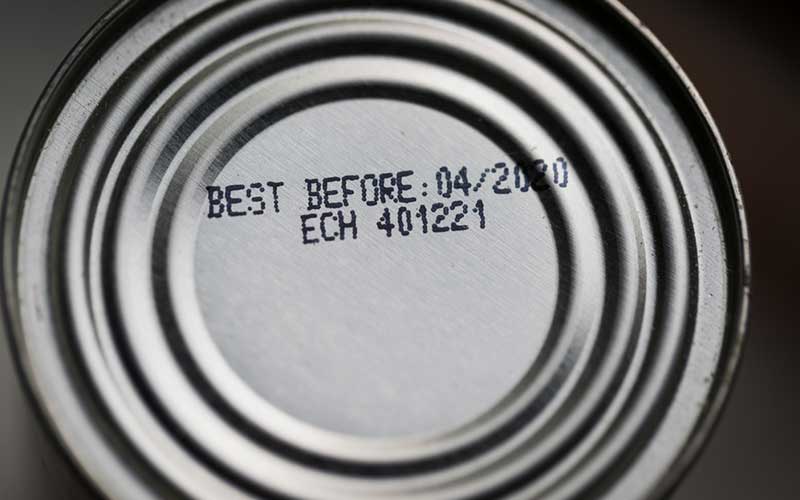
Several factors play into our food waste in America, but we have solutions to each of these problems. Photo: Shutterstock via CGstrein.
On average, there is an estimated 125 to 160 billion pounds of food waste in the U.S. each year. And where does it all end up? In a landfill, where it’s buried under mounds of toxic trash and eventually breaks down and emits methane. We bury so much organic waste that landfills are now the third-largest source of climate-damaging methane emissions in the U.S.
But the environmental impacts of wasting food don’t end there. By wasting food, we deplete precious resources, like water. In fact, agriculture in the U.S. accounts for about 80% to 90% of the nation’s water consumption. On top of that, when bad market conditions lead farmers to toss edible food aside or when sold foods is wasted, all the resources that went into producing those crops are squandered. There’s also a massive economic downside to throwing away uneaten food, adding up to approximately $218 billion a year in the U.S.
So, how did we start throwing out so much food? Well, several factors play into our increasing food waste in America. Here, we break down the causes of food waste and offer solutions that can help solve our problem.
Food Waste Facts and Food Waste Solutions
1. Confusing Labels
The Problem: Sell-by, best-by, use-by, best-before dates – you’ve seen each of these labels at the grocery store, but what do they all mean? If I buy an item on the sell-by date, when does it actually “go bad?” And is something truly “spoiled” after the best-before date? These labels confuse customers and lead many of us to throw away food prematurely. In fact, date label confusion accounts for about 7% of all consumer food waste in America.
The Food Waste Solution: Standardized date labels. If food retailers all used one label that clearly defined when a food product will go bad, there would be less confusion – and less food waste.
2. Oversized Servings and Containers
The Problem: Over the past few decades, serving and container sizes in the U.S. ballooned – and not just at restaurants and fast-food joints, but in grocery stores and homes. In fact, between 1977 and 1996, hamburgers grew by 23%, soda sizes by 52%, and snacks like potato chips, pretzels, and crackers by a whopping 60%. But how did bigger portions become the norm? Some blame movie theaters. Wanting to increase profits, theater owners in the 1960s upped their popcorn sizes, with the hopes that customers would pay a bit more for bigger buckets of their favorite snack – and they did.
The Food Waste Solution: Bigger isn’t always better. Many food retailers serve such large portions that you can’t eat a meal all in one sitting. And too often, the leftovers go uneaten at home, too. Restaurants and other food retailers can cut down on outrageously large serving and container sizes by way of portion control standards and scaling back food-packaging sizes.
3. The Quest for Perfect Produce
The Problem: Consumers expect their fruits and veggies in the perfect shape, size, and color. But the quest for flawless produce has serious downfalls. Because there’s little retail market for “ugly” fruits and veggies, large quantities of produce are left to rot in fields, go straight from the field to a landfill, or end up as livestock feed.
The Food Waste Solution: Just because a piece of produce looks funky doesn’t mean it’s bad. Changing the perception of “ugly” fruits and veggies can create a market for perfectly edible – if unique – produce. But, until that happens, we need to rescue “ugly” produce before it goes to waste. That means setting up systems to donate unwanted fruits and veggies to organizations that help feed the hungry and food insecure.
4. No Food Waste Tracking
The Problem: While recent years have seen a rise in food waste tracking technology, it’s not widely used by the food industry. Plus, the law doesn’t require food retailers to track their waste. But those who do use this software reap the benefits. By tracking inventory and waste, food retailers save a lot of money, as they’re no longer over-purchasing products or throwing as much away.
The Food Waste Solution: This one’s a no brainer – all food retailers should adopt technology that allows them to track food inventory and food waste. If they find that they’re over-purchasing an item – and throwing it away – they can adjust their restocking list.
5. Overstocked Stores
The Problem: In 2019, retailers like supermarkets wasted 10 million tons of food. Perishable items like baked goods, produce, meat, and ready-made foods account for most of these losses. While grocery and other retail store executives view the waste as a sign of quality control – keeping stores overstocked with only the freshest food – it comes at a steep price. In unsold fruits and veggies alone, the U.S. Department of Agriculture estimates that grocery stores lose around $15 billion a year.
The Food Waste Solution: Solving this problem comes down to two things: refining product management and reshaping consumer environments. That means food retailers must plan for demand by incorporating historical data into future decisions, adopt waste tracking technology, and shift the shopping experience to one that promotes better food management.
6. Lack of Accessible Food Rescue and Recycling Services
The Problem: Let’s face it, at one time or another, we’ve all forgotten about the celery in the back of the fridge. And when we do remember, the soft, droopy stalks end up in the trash can. That is unless you have a backyard composting bin or subscribe to a curbside organics recycling service. But while composting programs are on the rise, not everyone has access to them. The same goes for food rescue programs. You may want to donate extra soup cans, but if there’s no drop-off or pick-up service available, that food will likely go to waste.
Similarly, not all restaurants, grocery stores, and other food services and retailers have access to composting systems or food donation services. This causes them to throw away a combined total of about 23 million tons of food each year.
The Food Waste Solution: We must strengthen food rescue systems – and not just for non-perishable items, but for nutritious produce. That means making donation services more accessible, having food and retail businesses partner with donation centers, and increasing capacity at these centers. Any food remaining – like scraps or other items that are not safe to donate – should be recycled through composting or anaerobic digestion. But first, our cities and towns must make food recycling accessible. And they can do that by investing in composting infrastructure. All the while, food businesses can partner with industrial composters so that they, too, can recycle any remaining food scraps and stop wasting food.
Solving Our Food Waste Crisis
Several factors play into our increased food waste in America, but we have solutions to each of these problems. By reducing our food waste now, consumers and businesses can save money, precious resources won’t be misused, and the food insecure will have more high-quality, nutritious food to eat.
You can do your part at home by cutting down serving sizes, buying edible produce (regardless of how funky it looks), donating used food, and composting scraps. But there’s another role you can play: Zero Waste activist. That means using your voice to speak up and call on local businesses to cut their food waste.
Not sure where to begin? We’ve got you covered! Check out our Zero Waste Activism Toolkit to see how you can call on your favorite restaurants and food retailers to reduce their food waste. Together, we can bring more awareness to our food waste problem and make real change.



